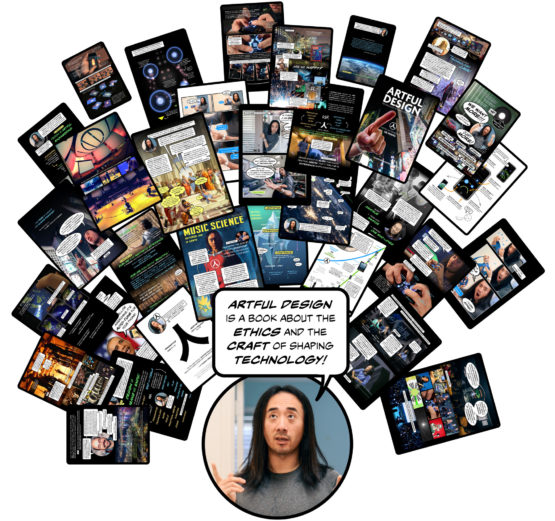Stanford polymath blazes a new trail with his design manifesto
Written as a photo comic book, Ge Wang’s publication charts new ethical and aesthetic territory.
Stanford scholar Ge Wang has chosen an unconventional medium for a manifesto about why technology and design needs to reflect human values: a comic book.
Go to the web site to view the video.
“It’s nerdy. It’s philosophical. It’s a core dump of my brain in comic form,” said Wang, an associate professor of music in the School of Humanities and Science, who has recently published Artful Design: Technology in Search of the Sublime (Stanford University Press). The book is designed to explore the nature and meaning of design itself, Wang said.
With the support of a Guggenheim Fellowship, Wang has spent the last three years creating a 488-page, full-color photo comic book about how humankind shapes technology and, in turn, how technology shapes humankind.
“The central premise of Artful Design is this: The way we think about technology needs to fundamentally evolve,” said Wang, who earned his doctorate in computer science and conducts his work as a hybrid designer, engineer and artist. “More than addressing our practical needs, technology should reflect our human values. The things we make ought to be not only functional, but beautiful, humanistic and socially meaningful. Above all, the shaping of technology must be truthful to who we are and who we want to be.”
From the start, Wang intended his project to be a design experiment using a radical, untraditional format. What emerged, eventually, was an expansive comic book.
“The medium ever shapes the message,” Wang said. “The way a book is written changes how the reader takes it in. Initially, I started writing a conventional book about technology-mediated design for music. Quickly, it turned into a book with a lot of images, and then I played with the idea of having comic book sections. At that point, I thought, ‘What if the entire book was a comic?!’ For better or worse, that’s how it became what it is today – a comic book manifesto on the artful design of technology.”
Art, philosophy and technology
Given the unconventional manifesto and medium, it is no surprise that Wang’s research and interests defy traditional categories. In addition to teaching, he creates programming languages for music, designs instruments and apps, and directs the Stanford Laptop Orchestra (SLOrk).

Ge Wang earned his doctorate in computer science and conducts his work as a hybrid designer, engineer and artist. (Image credit: Courtesy of Ge Wang and Stanford University Press)
When Wang was an undergraduate, there was no academic program that integrated his passions: computers, music, ethics and design. Creating this manifesto was his way to address the void.
“In a way, this book is about how engineering, art, the humanities and social sciences matter, and matter fundamentally, to one another. Ultimately, these are not separate pursuits,” said Wang, who is also an associate professor, by courtesy, of computer science in the School of Engineering.
His audience is, on the one hand, “the engineer with a soul,” and on the other, anyone who is curious or concerned about how technology shapes everyday life. Given the tools available that knit our social fabric together and keep us connected, the audience may be fast approaching everyone.
Wang is now teaching the kinds of courses that he sought as a student and he is using Artful Design as the textbook.
Comics in the classroom
Wang predicts that the engineers of tomorrow will need to be technological artists, moral-ethical inventors and system designers who operate with both reason and humanity.
One of those future engineers may very well be Wang’s student Arkira Chantaratananond, ’20, who is one of the first students to read the manifesto as a textbook. She said, “I’ve always appreciated design, but I never really knew why. Other than ‘design makes things look and feel nice,’ I didn’t know very much about design or why I was interested in it. Artful Design helped me understand the qualities of design that can elevate or deconstruct a society, and it helped me understand why design can bore us or rock us to our core. Ge’s book also helped me realize what kind of social and emotional design I want to focus my future work on.”
His fall course is Music, Computing, Design: The Art of Design, which explores creative design for computer music software. Students learn to create expressive music software, with emphases on audiovisual systems, human-computer interaction, aesthetics and value-based engineering.
Kunwoo Kim, MA ’19, said of the unorthodox textbook for the course, “While most textbooks exist in the functional dimension, Artful Design is both aesthetic and functional. The form of the textbook embodies its function. What could be a better textbook than one that achieves its goal not just ‘by saying’ but ‘by being’?”
The course is having an influence on Kim’s plan for the future. “I have a background in engineering and music, and it was a self-actualizing moment when I was able to synthesize the two fields to imbue humanistic sentiments into a technological medium. For example, I have been creating perspective-driven audiovisual narratives in virtual reality, which mixes technological and musical components to deliver artful stories on human values. I wish to pursue my career in artful design itself.”
In the winter Wang is teaching Think 66: Design that Understands Us with three Thinking Matters Fellows. Students will examine the nature, purpose and meaning of design in human life and explore ways that technology can speak to human values and express our humanity.
